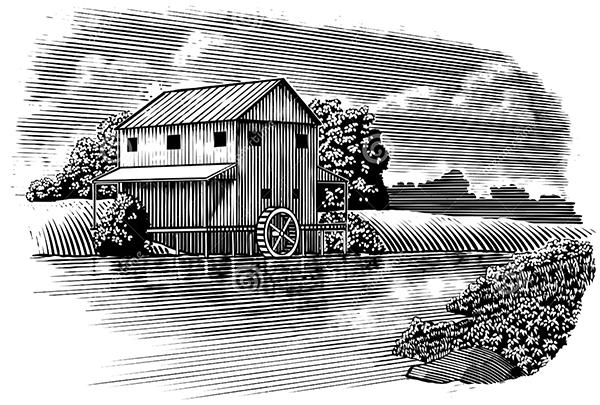
This is the eighth in a Series of Reminiscences by E. R. Brown. Brown was born in Pulaski County on August 9, 1845. His writings are abstracted from the Pulaski County Democrat on microfilm housed in the Pulaski County Public Library, Winamac, Indiana. Earlier entries can be found on our Newsletter page.
- Part one (Common Inconveniences) October 2018 newsletter.
- Part two (Land) June 2019 newsletter.
- Part three (Trees & Timber) November 2019 newsletter.
- Part four (The River) February 2020 newsletter.
Later editions are carried as separate posts.
- Part five (Public Roads)
- Part six (Schools)
- Part seven (Markets & Trading Points)
Published in Pulaski County Democrat, March 30, 1922
I cannot tell about the earliest saw and grist mills of the county from personal experience. They were in operation before my time. I remember seeing some of them later but was never in one. Of course the first settlers had to supply their needs from mills outside of the county, most of them going to White or Cass counties. The other adjoining counties were slower in developing these activities than our county. My father hauled the lumber required for frames and the one door of his cabin from below Monticello and had his early grinding done at Logansport. I think most early settlers near the river, especially those west of it, did the same. No early cabins had much sawed lumber in them and many had none. Floors were commonly laid with slabs split by hand and smoothed on top called ‘punchions’. I have been in many cabins which had no floors.
But as early as 1841, a saw mill seems to have been in operation at the north end of Winamac, run by water, obtained not from the Tippecanoe, but from ‘Quigley’s Branch’, and carried by a race which is still plainly visible. If this saw mill was not the first in the county no other one had long preceded it. Yet others were built around the same time and crude ‘corn crackers’, as they were called, soon followed, usually operated in connection with the saw mill. This does not mean that they could not or did not grind wheat, rye or buckwheat, but only that they were not equipped to make flour. It was more important in those early times to have facilities for converting corn into food than for wheat. Corn could be more quickly raised and was much more generally raised than wheat and was far cheaper when people had to buy it. Newcomers had to buy what they lived on until they could clear fields and until crops could mature, and for various reasons–floods, droughts, forest fires, trespass of stocks, sickness, etc., others had to buy it also.
These mills were mostly running, though some of them had been improved, when I was growing up, and were much talked about. Without reflections upon their respective owners or their worthy descendants, they were not only small but evidently of cheap, rough construction, with only such curious crude parts as could be afforded or as were easily available. Saw mills had only straight perpendicular saws, while grist mills had only small burrs, as might be taken for granted. If circular saws were then used it was long afterwards before they came here, and roller mills came much later. But the worst feature about these early mills was their lack of power. Their water wheels would scarcely turn a modern coffee grinder even if liberally provided with water, and the water supply was often short. In the driest weather they could not run at all, while for long periods at other seasons they could only run part of the time, having to wait for the water to accumulate above the dam.
These sawmills would not only be considered a joke at the present time, but were the objects of much merriment if not derision, in the days of their prime. If an inquiry was made as to whether or not any certain saw mill was running the reply was likely to be, “Sure, the saw is going up today and it may come down tomorrow”. Of the grist mills it was often said that if they were weak and slow there were also industrious, “Just as soon as they finished with one grain they grabbed right on to another”.
But with most other scant conveniences of the pioneers, these early mills were clearly a blessing. They rendered more accessible and cheaper shelter for both man and beast. In that way they raised the standard of comfort, health and happiness. These saw mills in particular; conserved and rendered available the timber supply, making it possible for the people to build for themselves better houses, barns, school houses and bridges, with churches added later.
It seems strange that not only all of these first mills should now be gone, with scarcely a trace left behind, but that their far more pretentious and respectable successors have likewise vanished. Barring a few portable saw mills, no others remain in all of Pulaski county.